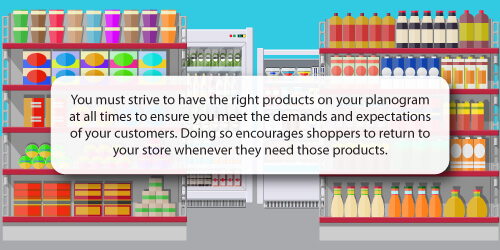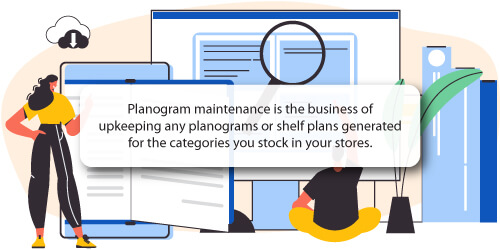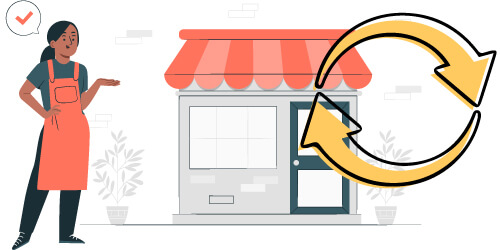Continuous planogram maintenance is vital for your short- and long-term retail success. However, that doesn't mean that the exercise is straightforward. That's certainly true if you approach such a task without care or consideration. Or if you fail to acknowledge the many factors that influence your final planogram.

We touch on each element you need to consider when reviewing or refreshing your planogram below. Before we do that, it's worth pointing out that that's not the main point. Instead, it's about how often you should update your planograms.
It's never a good idea to create a planogram and then leave it be. When built correctly, a data-driven planogram works for you rather than against you and requires continuous upkeep.
 What is planogram maintenance?
What is planogram maintenance?
As a concept, there is not much to planogram maintenance. That's because any explanation is relatively straightforward.
 Also referred to as POG maintenance, it's about continuously upkeeping any planograms you build to ensure they're up to date with consumer demand.
Also referred to as POG maintenance, it's about continuously upkeeping any planograms you build to ensure they're up to date with consumer demand.
That said, as easy as it might be to understand, you should never underestimate its importance. After all, your planograms are arguably one of the most crucial category management tools available to you. And the last thing you should do is jeopardise their effectiveness.
There is also the fact that a planogram is a living, breathing document. It's neither static nor set in stone. That's why you can't set one up once and expect it to continue to work.
Below are a few more reasons why you can’t set and forget any planogram you build.
1. Your product ranges constantly change
The first reason why planogram maintenance is critical is that your product ranges change continuously. At least, they should if you want to remain relevant to your customers and offer them the products they want.
That means adding and removing products from your planogram when necessary. It's also known as listing or delisting lines.
Do you want to improve the profitability and efficiency of your categories? Book a complimentary consultation with a DotActiv expert and we can show you how DotActiv software enables you to do that.
By the way, this isn't a ranging exercise, which is more extensive but just as crucial to complete. Instead, it's about those micro changes - tweaks - worth implementing to ensure your product range remains suitable to what customers want when they visit your store.
For example, if a product isn't performing as expected, you should look to either remove it (delist) or reduce its facings. Then, if there is any gap on the shelf, you can fill it with an item that will offer you better sales and profits. Or you might see an opportunity to open up on specific sub-categories.
To fully capitalise on any of the above opportunities, you must communicate these changes to your space plan - something you can only do if you continuously review and refresh them.
2. Your retail data doesn't stay the same
The fact that you're implementing planograms in-store means that you're altering shopping behaviour.
As a result of this change, your sales data changes too. Shoppers will purchase more of one product and less of another. It could be because of the season or because a product has reached the end of its lifecycle and is no longer available.
Whatever the reason, as consumer behaviour shifts, you need to adapt your planograms and their layout accordingly. If you don't, you could find your shelves stocked with products that no one wants to buy. And the consequences can include everything from dead stock to dwindling sales and reputation loss.

How often should you review or refresh your planograms?
The fact that you must review and refresh your planograms should no longer be up for debate if it ever were in the first place. That said, it's still worth having the conversation because it leads naturally to a question about frequency: how often should you review and update your planograms?
If the first question was easy to answer, the second is a little more complicated.

The general rule of thumb is to review and update your planograms once every quarter or every six months. Any more than that, and you could find yourself misusing your time.
Here's why:
Every time you refresh your planograms, you flush in new data to ensure the products on your shelf plan are meant to be there and have the correct space allocation. If you update monthly, for example, you could end up with skewed data that doesn't tell you the whole story.
Of course, other factors will influence how often you update your shelf plans.
1. It depends on the category
The first factor that can have a saw in how often you review or refresh your planograms is the category itself.
Let's say, for example, you stock Canned Vegetables. For this category, you would probably look to refresh your shelf plans twice a year because you know Canned Soup (which forms part of the product grouping) picks up during winter and drops off during summer.
That would be the same for many other food categories and food retailers. Refreshing your planograms twice a year is a best practice.
Of course, you do need to plan any refresh. Since there are always new lines available for you to stock, a good idea would be to give new products three to six months to perform, after which you can re-evaluate their space on the shelf.
2. It depends on the seasonality
A second factor, intrinsically linked to the first, is seasonality. With a seasonal category, you'd typically update your planograms throughout the season.
For example, you wouldn't update your Sunscreen planogram during the middle of winter because it wouldn't make sense. Instead, you'd do it when customers purchase products from within the category.
If we were to focus specifically on seasonal periods such as Christmas, Easter or a similar event, you'd do the same, updating the products on the planograms while they're available. Once the period or event is over, you'd remove those SKUs and give the space to other products that offer you a better return on your investment.

What can prevent you from maintaining planograms effectively?
As much as you might want to begin and complete a planogram maintenance exercise, there are instances where you can't do so effectively. Knowing these can help you avoid them. And if you can't avoid them, at least be prepared to mitigate any potential consequences.
1. On-the-ground implementation
One such factor is the actual on-the-ground implementation. You need to be aware of the best practices around reviewing and refreshing planograms for your categories.
For example, as noted above, you can’t have your stores implement planograms every week or month. Besides it being unadvisable, there isn’t enough time for your data to show any significant changes.
2. Time factor
There is also the time required to process your planograms. Let's say you have 3000 planograms. If you were to review and refresh them four times a year, that would be 12 000 planograms each year.
Of course, if you have a large team, it's easier to complete it. However, if you have a lean team, it's impractical.
3. Skewed and/or incorrect retail data
Besides the above two factors, skewed data due to promotions can play a critical role in preventing you and your staff from maintaining your planograms effectively.
It's best to work alongside your buyers to ensure you apportion your shelf space appropriately to avoid such a scenario. Doing so also allows you to consider any promotion sales to avoid overfacing on any items.
4. Your suppliers aren't ready
Another factor that can hamper your effectiveness is when your suppliers aren't ready. They need to have their new listings in order by the time you want to refresh your planograms. Your discontinued lines also play a role here.
You must also remove any discontinued SKUs irrespective of the refresh period since they will influence how much space you have available on your shelf.
 Conclusion
Conclusion
Continuously reviewing and updating your planograms is critical for successful category management. If you can get such an exercise right and consistently, you can ensure to please any customers walking into your store. More importantly, it can help you lay the foundation for long-term success.
Are you looking for a category management solution that can help you present your customers with logical and shopper-friendly product layouts while improving your shelf space efficiency? Why not book a complimentary consultation with a DotActiv expert here? You can also browse through our various software and service options on our online store here.


